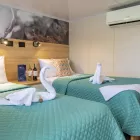This site gets its name because it was used by pirates and buccaneers during the XVII and XVIII centuries as a place to hide and get freshwater and tortoises. The place is very scenic with beautiful cliffs and interesting rock formations. There is no trail, but here you will take a dinghy to look at wildlife from the small boats. Snorkel: You can snorkel in a sheltered bay which is teaming with underwater wildlife including large schools of fish (angelfish, puffers, parrotfish, snappers, grunts…) but also reek sharks, sea lions and sea turtles.
Highlights: Boobies, herons, Galapagos fur seals, swallow-tailed gulls, Galapagos hawks.
Espumilla is a beautiful 1km (0.6 mi) long beach with rusty-brown sand, located in the northern coast of Santiago. It is surrounded by large mangrove trees and a very interesting native dry forest, which is home to Galapagos hawks but also a great diversity of finches, mockingbirds and doves. Don’t forget to check the salt pan, as during the rainy season there could be flamingos and ducks.
Highlights: Bobbies, oystercatchers, herons, Galapagos mockingbirds, Darwin finches, Galapagos hawks.
Trail: 2.3 km / 1.4 mi (plus and extra loop 1 km-0.6 mi)
Level: Easy
Hiking, Snorkeling, Panga ride, Paddle boarding, and Kayaking
Despite its name, there is no “port” at Puerto Egas, but you might see a few remains of the last attempts to colonize the island during the 60’s. The trail goes along the coastline which is rich in wildlife, with marine iguanas basking in the sun everywhere, Galapagos sea lions, herons, oystercatchers and many shorebirds. At the end of the trail an area called “the grottos” is home for a small colony of the endemic Galapagos fur seal, much more difficult to see at close range than its cousin. As recently as 2019, land iguanas were reintroduced to the area, so look around for these impressive reptiles which were extinct from Santiago for over a century.
Snorkel: You can snorkel from the beach and explore an area of rocky bottoms which is excellent for fish, turtles and reef sharks. Often, sea lions are also present and are happy to interact with divers.
Highlights: Galapagos sea lions, Galapagos fur seals, oystercatchers, marine & land iguanas, Galapagos hawks, herons, shorebirds, Darwin finches, Galapagos doves.
Trail: 2.3 km / 1.4 mi
Level: Easy
Wet landing, Hiking, and Snorkeling

















